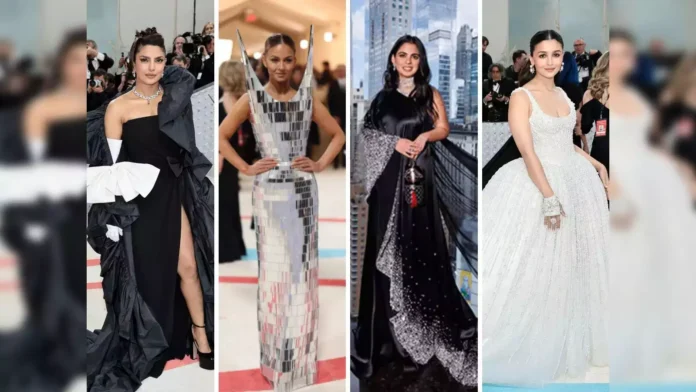Indian fashion designers are noticeably absent from the prestigious Met Gala 2024, leaving many in the fashion community questioning the reasons behind this absence. Among those missing are prominent names like Shubhika Sharma, the creative force behind the immensely popular brand Papa Don’t Preach, and the Chairman of the Fashion Design Council of India (FDCI). Their absence has sparked discussions within the Indian fashion industry about the significance of representation on such global platforms.
Shubhika Sharma, known for her innovative and eclectic designs, expressed her disappointment at not being part of the Met Gala this year. She emphasized the importance of Indian designers showcasing their talent on international stages like the Met Gala to gain recognition and exposure on a global scale. Sharma believes that the absence of Indian designers at events like these perpetuates the notion that Indian fashion lacks the creativity and innovation seen in Western fashion.
Similarly, the Chairman of the FDCI, whose role involves promoting Indian fashion globally, shared concerns about the lack of Indian representation at the Met Gala. He highlighted the need for Indian designers to break into the international fashion scene and establish themselves as leaders in the industry. According to him, participation in events like the Met Gala is crucial for Indian designers to gain visibility and credibility among the international fashion community.
The absence of Indian fashion designers at the Met Gala raises questions about the inclusivity and diversity of the event. While the Met Gala prides itself on celebrating fashion from around the world, the limited representation of Indian designers suggests a gap in recognizing the contributions of non-Western fashion communities. This disparity underscores the need for greater inclusivity and representation of diverse voices in the global fashion landscape.
In response to the absence of Indian designers at the Met Gala, many in the Indian fashion community are calling for initiatives to support and promote homegrown talent on international platforms. They emphasize the importance of fostering a supportive ecosystem that nurtures emerging designers and provides them with opportunities to showcase their work on a global stage.
Despite the absence of Indian fashion designers at the Met Gala 2024, there is a growing recognition of Indian fashion’s influence and potential on the global stage. Indian designers have been making strides in the international fashion scene, with their unique aesthetic and craftsmanship garnering attention from fashion enthusiasts worldwide. Brands like Sabyasachi, Manish Malhotra, and Anita Dongre have gained international acclaim for their exquisite designs, worn by celebrities and featured in prestigious fashion publications.
One of the factors contributing to the success of Indian fashion designers on the global stage is their ability to blend traditional craftsmanship with contemporary aesthetics. Indian designers draw inspiration from rich cultural heritage, incorporating elements like intricate embroidery, vibrant colors, and luxurious fabrics into their creations. This fusion of tradition and modernity resonates with audiences globally, offering a fresh and distinctive perspective in the world of fashion.
In recent years, Indian fashion has also gained prominence through collaborations with international brands and designers. Collaborations between Indian designers and global fashion houses have led to innovative collections that celebrate the diversity of fashion influences. These collaborations not only showcase Indian craftsmanship but also provide Indian designers with opportunities to reach new audiences and expand their presence in the global market.
Furthermore, the rise of social media and digital platforms has played a significant role in amplifying the reach and visibility of Indian fashion designers. Platforms like Instagram have become powerful tools for designers to showcase their work, connect with consumers, and engage with a global audience. Through carefully curated content and strategic marketing efforts, Indian designers have been able to build strong online communities and attract attention from fashion enthusiasts worldwide.
Despite these achievements, Indian fashion designers still face challenges when it comes to breaking into the elite circles of the global fashion industry. Limited access to resources, lack of infrastructure, and stiff competition from established Western brands are some of the hurdles that Indian designers must overcome to gain recognition on the international stage. Additionally, perceptions of Indian fashion as traditional or ethnic may pigeonhole designers and limit their opportunities for exposure on global platforms.
To address these challenges and foster greater representation of Indian fashion at events like the Met Gala, there is a need for continued support and investment in the Indian fashion ecosystem. This includes initiatives to provide designers with access to mentorship, resources, and opportunities for collaboration with international partners. Additionally, efforts to challenge stereotypes and broaden the understanding of Indian fashion as diverse, innovative, and forward-thinking can help reshape perceptions and elevate Indian designers on the global stage.
As the Indian fashion industry continues to evolve and assert its presence on the global stage, the hope is that Indian designers will increasingly find their place among the luminaries of the international fashion scene. With a combination of talent, creativity, and strategic initiatives, Indian fashion has the potential to shine brightly on prestigious platforms like the Met Gala, showcasing the rich tapestry of India’s sartorial heritage to the world.

